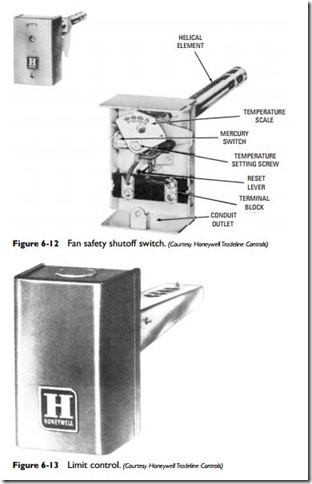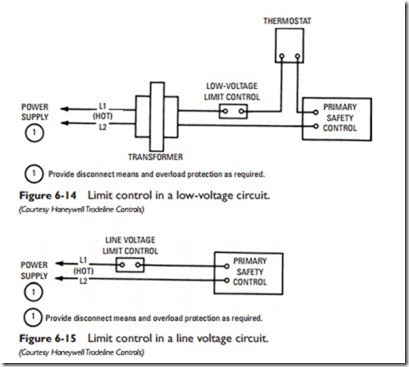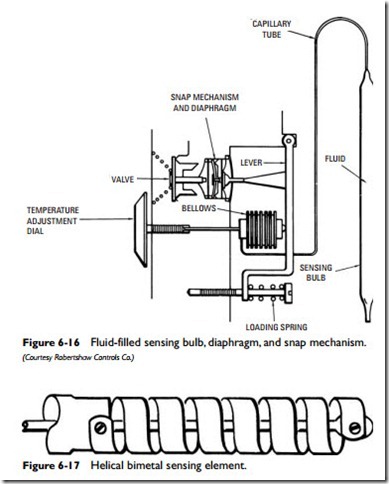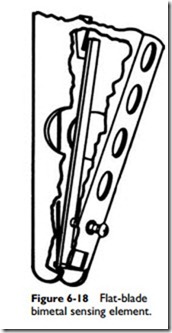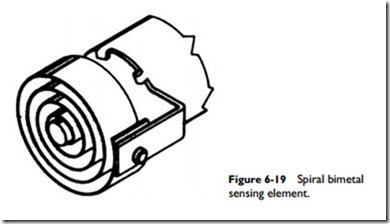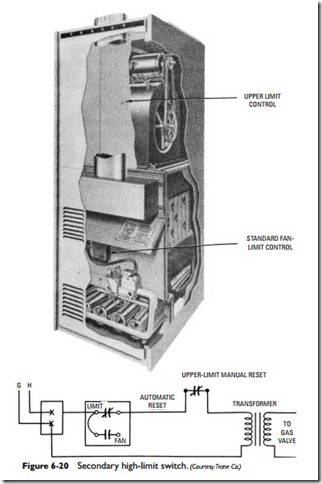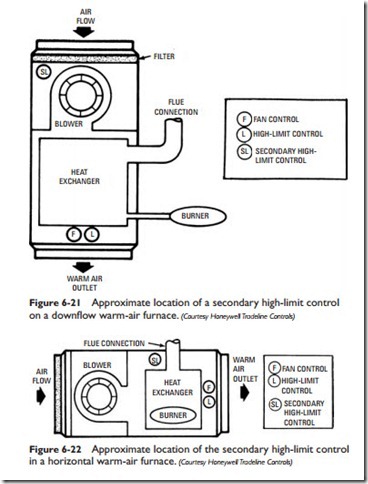Limit Controls
Limit controls are also used to prevent the buildup of excessive and dangerous high temperatures in the furnace plenums. They accomplish this task by shutting off the burner when the maximum temperature setting on the control is reached and by turning it on again when the air temperature returns to normal.
The following limit controls are described in this chapter:
• Limit control
• Secondary high-limit switch
Limit Control
A limit control is a device designed to provide high-limit protection for a forced warm-air furnace (see Figure 6-13). It controls the operation of a burner or burner assembly in response to air temperature changes in the furnace plenum. If the air temperature in the plenum becomes excessively high, the limit controller shuts off the burner or burner assembly until the air temperature returns to normal.
Limit controls are available in models suitable for use in low- voltage, line voltage, and self-energizing (millivolt) systems. Typical wiring hookups for these different systems are shown in Figures 6-14 and 6-15. These limit controls have so-called universal contacts in the limit switch, which makes them suitable for all voltages from millivolt to line voltage.
A limit control contains a snap-action switch operated by either a fluid-filled or bimetallic sensing element.
Fluid-filled sensing elements are connected to the control by a length of capillary tube, which is available in lengths up to 72 inches. The tube is filled with a temperature-sensitive liquid. A temperature change causes the liquid to expand against a diaphragm that operates a snap-action switch (see Figure 6-16).
Bimetal sensing elements are available in helical, flat-blade, and spiral types (see Figures 6-17, 6-18, and 6-19). The bimetal sensing element is connected directly to the switch operator.
The temperature setting of the limit control should be high enough not to interfere with the normal operation of the furnace, but low enough to shut off the burner or burner assembly before air temperatures in the furnace plenum reach the danger point. After the temperature in the furnace plenum has cooled and dropped below the setting on the limit control, the limit switch closes and starts the burner or burner assembly again.
Secondary High-Limit Switch The same type of air switch used to provide two-speed control of fan motors can also serve as a secondary high-limit switch (or upper-limit con- trol) on downflow or horizontal warm- air furnaces (see Figure 6-20).
Downflow and horizontal furnaces are sometimes subject to a reverse air circulation condition that can result in a dangerous buildup of temperatures. This condition is usually caused by fan failure or clogged filters. The secondary high-limit switch is a safety device used as a backup system for the regular high- limit controller (see Figure 6-3). It is particularly important to have a secondary high-limit switch on a furnace if there is a possibility that the location of the regular high-limit controller may cause it to fail to detect a fan malfunction.
The secondary high-limit switch is located between the filter and the furnace fan (see Figures 6-21 and 6-22).
When the air temperature exceeds a certain setting, the switch opens and shuts off the burner or burner assembly and turns on the fan. Secondary high-limit switches are either automatic or manually
reset types. The automatic type is a single-pole, double-throw (SPDT) switch that turns on the burner when the limit cuts out. The manually reset switch must be reset before the burner will operate again.
When the air temperature between the filter and the heat exchanger reaches the setting (i.e., setpoint) in the air switch, one internal switch closes (R to W) and another opens (R to B). This operation shuts off the burner and starts the fan.
